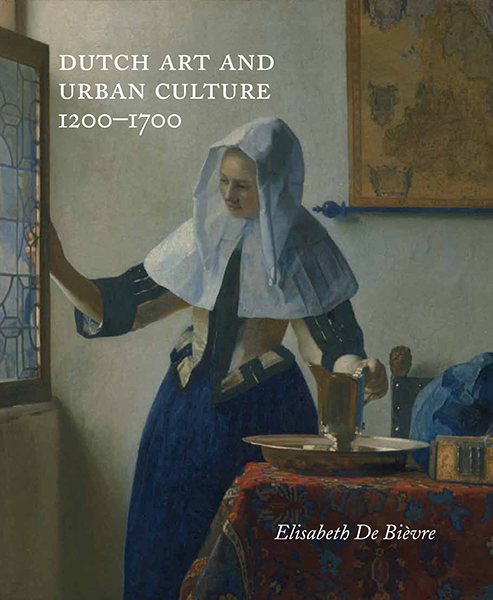 In Elisabeth de Bièvre’s book Dutch Art and Urban Culture, 1200-1700, the author explains how distinct geographical circumstances and histories shaped unique urban developments in different locations in the Netherlands and, in turn, fundamentally informed the art and visual culture of individual cities. In seven chapters, each devoted to a single city, the book follows the growth of Amsterdam, Delft, Dordrecht, Haarlem, Leiden, The Hague, and Utrecht over the course of five centuries. By embracing the full gamut of art and architecture and by drawing on the records of town histories and the writings of contemporary travelers, de Bièvre traces the process by which the visual culture of the Netherlands emerged to become the richest, most complex material expression in Europe, capturing the values of individuals, corporate entities, and whole cities. In a series of posts, de Bièvre offers a snapshot of each of these seven cities as expressed through a set of representative artworks.
In Elisabeth de Bièvre’s book Dutch Art and Urban Culture, 1200-1700, the author explains how distinct geographical circumstances and histories shaped unique urban developments in different locations in the Netherlands and, in turn, fundamentally informed the art and visual culture of individual cities. In seven chapters, each devoted to a single city, the book follows the growth of Amsterdam, Delft, Dordrecht, Haarlem, Leiden, The Hague, and Utrecht over the course of five centuries. By embracing the full gamut of art and architecture and by drawing on the records of town histories and the writings of contemporary travelers, de Bièvre traces the process by which the visual culture of the Netherlands emerged to become the richest, most complex material expression in Europe, capturing the values of individuals, corporate entities, and whole cities. In a series of posts, de Bièvre offers a snapshot of each of these seven cities as expressed through a set of representative artworks.
Here are a links to the previous four posts, on The Hague, Dordrecht, Haarlem, and Delft.
Leiden developed on the confluence of two branches of the Rhine, about 10 kilometers (just over 6 miles) from the North Sea. Although the river mouth silted by the second half of the 12th century, contacts with Britain had been consolidated over many centuries.

Raw wool imported from England and washed in the river became the basis for Leiden’s flourishing cloth industry, one of the greatest sources of wealth in the early modern period. But the manufacturing process was highly labour-intensive and extremely polluting, which made Leiden not only over-populated, but prone to deadly epidemics. These circumstances were visualized in varied ways. The intersecting branches of the river were reflected in the city’s coat of arms, the crossed keys of St. Peter, Leiden’s city patron.
The earliest known altar pieces show overcrowded scenes, where death is omnipresent, as in Cornelis Engelbrechtsz’s Crucifixion with the rare subject of Adam’s Corpse in the predella.
Cornelis Engelbrechtsz, Central Panel and Predella of Triptych with the Crucifixion, 1510-22 (oil on panel). Leiden Museum, De Lakenhal
While thousands of textile workers were killed by the plague, the industry itself gave women plenty of opportunities for employment. Working women acquired more prominent public visibility and became a force to be reckoned with. Lucas van Leyden’s early 16th-century rich feminine imagery reveals this in spectacular fashion.
 Lucas van Leyden, Phyllis and Aristotle, c. 1515 (wood engraving)
Lucas van Leyden, Phyllis and Aristotle, c. 1515 (wood engraving)
The role of women in the wool industry is also celebrated a hundred years later by the burgomaster/painter, Isaac Claesz van Swanenburg.

Isaac Claesz van Swanenburg, Wool Workers, c. 1607 (oil on panel). Leiden, Museum De Lakenhal
The theme of mortality was perpetuated deep into the 17th century. Leiden vanitas still lifes show more often than elsewhere skulls and ephemeral bubbles, the latter no doubt inspired by the soap bubbles that were an necessary byproduct of wool washing. In a similar vein, Frans van Mieris the Elder projects transience onto a genre scene in his Boy Blowing Bubbles.

Frans van Mieris the Elder, Boy Blowing Bubbles, 1663 (oil on panel). The Hague, Royal Picture Gallery Mauritshuis
Elisabeth de Bièvre is an independent scholar who has taught at the University of East Anglia Norwich, the University of California, Los Angeles, and University College London.


 Ep. 134—The Therapeutic Benefits of Reading Greek Tragedy
Ep. 134—The Therapeutic Benefits of Reading Greek Tragedy